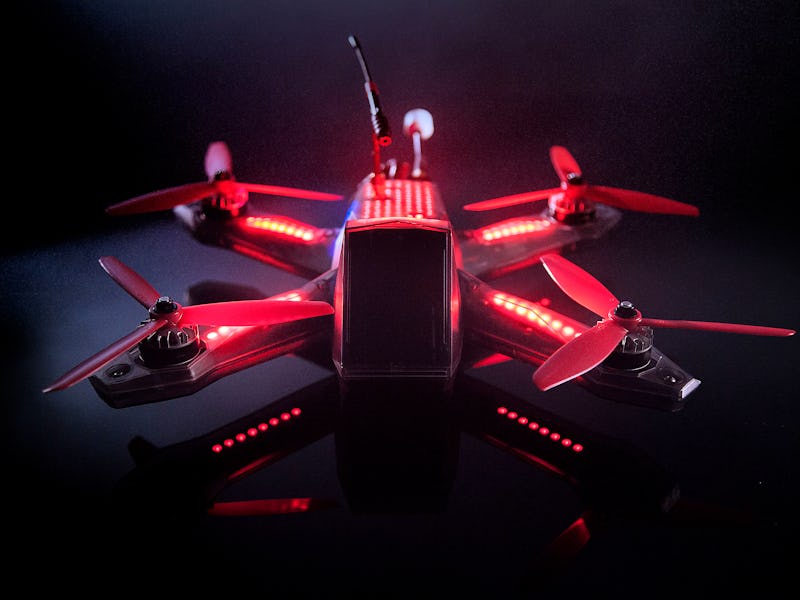The Drone Racing League Reveals Its "Batmobile" Drone
The new Racer3 isn't for beginners, but that's the point.

Sure, the 210 LED lights on the Racer3 drone add weight to a vehicle built for speed, but the trade-off for each little blinker is worth it to the Drone Racing League, the fledgling organizational apparatus set up around the cool-sounding sport with a visibility problem and dump trucks of money backing up to its offices.
But with or without the flashing LED’s, the Racer3 — unveiled Thursday by the DRL — looks cool, especially when compared to the Racer2, the drone used during last year’s inaugural DRL season.
When the second season airs on ESPN on June 20, the Racer3 will hit 80 mph on TVs in 75 countries. The DRL’s finished taping half of its six races already, but they won’t be broadcast until this summer, via slickly edited one-hour packages, similar to how the Worldwide Leader packages the World Series of Poker.
The two-year-old DRL has also seen added to its television deal the backing of Allianz Insurance, the Munich-based multinational that, yes, also sells drone insurance. The five-year title sponsorship rebrands the six-race 2017 season as the Allianz World Championship, and as Forbes commented after the deal was announced in February, it is a “huge deal” for the start-up. There’s a lot riding on those FPV (first-person view) drones.
At the league’s office in Manhattan this week, CEO and league founder Nicholas Horbaczewski told Inverse about his vision for the DRL in the over-stuffed workshop, next to scores of Racer3 drones, neatly lined up ahead of the fourth race on April 13, set at an abandoned factory in Fitchburg, Massachusetts.
“It’s more Batmobile than it is DIY, 3D-printed drone,” Horbaczewski says of the Racer3, which will zip through around and through neon gates that mark the DRL’s 3D race courses.
The Racer3 appears sleek and modern, thanks to a hardened polymer shell that encases its electronics. It now looks less like an engineering project and more like a vehicle.
“There’s only so much you can do at 80 mph, but yeah, it definitely gives us a bigger surface area,” Horbaczewski says when asked if the drones could be covered in sponsor logos à la NASCAR.
The mind can’t help but make car comparisons: The Racer2 is the Ford Model T; the angular Racer3 resembles, like, a 1993 Ford Mustang 5.0. It’s as aggressive-looking as a thing with four propellers can be.
“Visibility is huge in this sport, you’ve seen the thing; it’s the size of a big plate and it goes 85 mph, and it will accelerate from 0-80 in less than a second,” Horbaczewski says.
On the left, the Racer2; on the right, the Racer3.
In a separate interview later, Ryan Gury, employee #2 at the DRL and its director of product, also compares the Racer3 to the Batmobile. Gury, a wiry engineer who wears thick Ray-Bans, was recruited by Horbaczewski, a former executive at Tough Mudder, the punishing races for weekend warriors. Gury comes from the DIY drone-racing community, evidenced by the no-frills, engineering-focused Racer2, and Horbaczewskif from the tenacious world entrepreneurial world of start-ups.
“Drones that are duct-taped together don’t really look sexy, and we wanted to make it look sexy, we wanted to make it look like the Batmobile,” says Gury, the company’s “Leonardo da Vinci of drone racing,” a nickname given to him by Horbaczewski in an interview with Sports Illustrated. “[We wanted to] have something that looked like a stealth fighter, has 210 LED’s on it, and can fly for three minutes.”
To power all of those lights and longer flight times, the Racer3 has a bigger, denser battery, the 1800mAh 4s 75c Lipo. The drone has six-inch propellers to lift its two-pound body as high as five miles in altitude. It has two cameras, one that captures real-time video for pilots to watch on a headset as they fly the drones, and an HD camera for the TV broadcast.
It’s time to break the news: There’s no way the Racer3 is going to be sold to consumers. It’s full of proprietary radio technology and there are regulatory matters to consider. It’s also incredibly hard for beginners to even get it off the ground, unlike the more consumer-friendly, GPS-enabled DJI Phantoms, which are essentially flying cameras.
“Our focus is to create the most incredible racing that you can see on TV,” Horbaczewski says. “Selling a commercial drone is a big distraction from that; it’s a totally different business.”
Which is why a deal with Toy State, a radio-controlled toy company, was struck. It will sell a DRL-branded toy drone starting in August for about $170, which gives people a sense of flying a racing drone like a go-cart gives a person a sense of driving a Formula 1 vehicle. A more accurate experience comes via a free downloadable flight simulator created by the DRL that will be a feeder league for new drone pilots, as it’s already become: One of the racers in Season 2 was a leader in the online simulator and won the Bud Light 2017 Try-Outs. He’s doing well in the league so far.
As he shows how it works in the DRL conference room, it’s apparent that the Racer3 really is Gury’s baby. It shows when he talks about the races where pilots put the sturdy drones through the ringer. An on-site team brings a fleet of backup drones for every race because aggressive driving is encouraged.
“We’re starting to see this incredible sport emerge that we all envisioned, but now it’s really legit,” Gury says, holding the Racer3. “I think when people see this new season, it’s not going to be a question of ‘is this is a sport?’ anymore.”